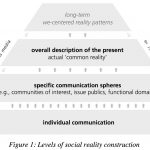Querverweis: Wikimedia – Closing for the Benefit of Openness?
12. Januar 2018In den Organization Studies ist jüngst der kostenfrei abrufbare Artikel »Closing for the Benefit of Openness? The case of Wikimedia’s open strategy process« von Laura Dobusch, Leonhard Dobusch und Gordon Müller-Seitz erschienen, der sich mit dem Verhältnis von Offenheit und Geschlossenheit in Open-Content-Communities auseinandersetzt. Der Text kommt zu dem Schluss, dass eine offen-partizipative Erarbeitung von Inhalten mit Schließungsprozessen in der Strategieentwicklung einhergeht (vgl. dazu: »Open-source Projects as Incubators of Innovation«):

»Following Ashcraft’s work on ›organized dissonance‹ […], we do not understand the necessity of ›closing for the benefit of openness‹ as a contradiction but rather as a productive dynamic that comprises ›pushes and pulls that become a check-and-balance system‹. In order to establish such a check-and-balance system […] we strive to identify ›enabling types of bureaucracy‹ (Adler & Borys, 1996, p. 85). ›Enabling‹ in our reading implies that the rules, procedures and instructions codify ›routines so as to stabilize and diffuse new organizational capabilities‹ (Adler & Borys, 1996, p. 69) and that they are compatible with the normative requirements underlying open qualities: broad participation and collaboration of various internal and external stakeholders […].
Against this background, we propose a two-dimensional, interrelated framework of openness, in which the interplay of open and closed elements provides the basis for enacting ideals of organizational openness:
The first dimension of openness, procedural openness, provides the preconditions for content-related openness, which, however, can be modified recursively provided that the decision-making opportunities entail certain open qualities […]. Basically, procedural openness concerns the whole composition of the strategy-making process with a particular focus on establishing a reliable checks-and-balances system. In a nutshell, procedural openness requires predetermined and transparent procedures in order to restrict opportunities for individual actors or informal groups to change ›the rules’ flexibly‹ […].
[…] the second dimension […] content-related openness […] concerns all the actually performed activities related to access to sensitive information, the modes of participation and the modes of decision-making. With respect to information access, content-related openness implies enabling a flow of information as open as possible via channels mastered by target audiences in order to stimulate their desire to participate. […] content-related openness also implies that the core elements of the strategy-making process are not protected from becoming a matter of decision-making, if openness in terms of a checks-and-balances system is taken seriously […].
[…] Applying our two-dimensional framework […] to the four phases of Wikimedia’s strategy-making process, we see that only the first two phases reflect a combination of elements related to content-related openness (information about starting the strategy process, contributing strategy-relevant proposals) and procedural openness (explicit instructions and rules about how to deal with the proposals) as suggested by the framework. In contrast, the third and fourth phases are characterized by open participation policies (discussing, categorizing and condensing) and closed forms of decision-making (informal, opaque ways of decision-making by Wikimedia officials and con- sultants) that run counter to what our framework recommends. Procedural openness, in terms of a closed design of the overall structure of the strategy-making process that is thereby open to rule-based changes by its participants, is not implemented in any of the four phases.«













